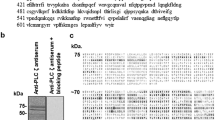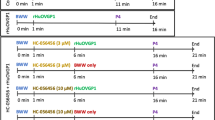Abstract
Propose
The present study examined whether regulation of progesterone-enhanced hyperactivation of spermatozoa is associated with the production of inositol 1,4,5-trisphosphate (IP3) and diacylglycerol (DAG) by phospholipase C (PLC) and cyclic adenosine monophosphate (cAMP) by adenylate cyclase (AC), as well as activation of protein kinase C (PKC) and protein kinase A (PKA).
Methods
Hamster spermatozoa were hyperactivated by incubation for 4 h in modified Tyrode’s albumin lactate pyruvate (mTALP) medium. In order to examine the effects of IP3 receptor (IP3R), PKC and PKA on progesterone-enhanced hyperactivation, their inhibitors (xestospongin C, bisindolylmaleimide 1 and H-89) were used.
Results
Progesterone-enhanced hyperactivation was significantly suppressed by the inhibitors of IP3R, PKC and PKA.
Conclusions
The results suggest that progesterone-enhanced sperm hyperactivation occurs through two signal pathways. One is an intracellular Ca2+ signal through production of IP3 and DAG by PLC, binding of IP3 to IP3R and activation of PKC by DAG and Ca2+. The other is a cAMP–PKA signal through production of cAMP by AC and activation of PKA by cAMP.



Similar content being viewed by others

References
Yanagimachi R. Mammalian fertilization. In: Knobil E, Neill JD (eds). The physiology of reproduction, 2nd edn. New York: Raven Press; 1994. p. 189–317.
Fujinoki M. Non-genomic regulation of mammalian sperm hyperactivation. Reprod Med Biol. 2009; 8:47–52.
Suarez SS, Ho HC. Hyperactivated motility in sperm. Reprod Domest Anim. 2003; 38:119–24.
Baldi E, Luconi M, Muratori M, Marchiani S, Tamburrino L, Forti G. Nongenomic activation of spermatozoa by steroid hormones: facts and fictions. Mol Cell Endocrinol. 2009; 308:39–46.
Yudine AI, Gottlieb W, Meizel S. Ultrastructural studies of the early events of the human sperm acrosome reaction as initiated by human follicular fluid. Gamete Res. 1988; 20:11–24.
Noguchi T, Fujinoki M, Kitazawa M, Inaba N. Regulation of hyperactivation of hamster spermatozoa by progesterone. Reprod Med Biol. 2008; 7:63–74.
Fujinoki M. Melatonin-enhanced hyperactivation of hamster sperm. Reproduction. 2008; 136:533–41.
Fujinoki M. Serotonin-enhanced hyperactivation of hamster sperm. Reproduction. 2011; 142:255–66.
Langlais J, Roberts KD. A molecular membrane model of sperm capacitation and the acrosome reaction of mammalian spermatozoa. Gamete Res. 1985; 12:183–224.
Okamura N, Tajima Y, Soejima A, Masuda H, Sugita Y. Sodium bicarbonate in seminal plasma stimulates the motility of mammalian spermatozoa through direct activation of adenylate cyclase. J Biol Chem. 1985; 260:9699–705.
Visconti PE, Kopf GS. Regulation of protein phosphorylation during sperm capacitation. Biol Reprod. 1998; 59:1–6.
Visconti PE, Stewart-Savage J, Blasco A, Battaglia L, Miranda P, Kopf GS, et al. Roles of bicarbonate, cAMP, and protein tyrosine phosphorylation on capacitation and the spontaneous acrosome reaction of hamster sperm. Biol Reprod. 1999; 61:76–84.
Fujinoki M, Kawamura T, Toda T, Ohtake H, Ishimoda-Takagi T, Shimizu N, et al. Identification of 36-kDa flagellar phosphoproteins associated with hamster sperm motility. J Biochem. 2003; 133:361–9.
Fujinoki M, Kawamura T, Toda T, Ohtake H, Ishimoda-Takagi T, Shimizu N, et al. Identification of 36 kDa phosphoprotein in fibrous sheath of hamster spermatozoa. Comp Biochem Physiol B: Biochem Mol Biol. 2004; 137(4):509–20.
Fujinoki M, Ishimoda-Takagi T, Ohtake H. Serine/threonine phosphorylation associated with hamster sperm hyperactivation. Reprod Med Biol. 2004;3:223–30.
Fujinoki M, Suzuki T, Takayama T, Shibahara H, Ohtake H. Profiling of proteins phosphorylated or dephosphorylated during hyperactivation via activation on hamster spermatozoa. Reprod Med Biol. 2006; 5:123–35.
Visconti PE, Moore GD, Bailey JL, Leclerc P, Connors SA, Pan D, et al. Capacitation of mouse spermatozoa II. Protein tyrosine phosphorylation and capacitation are regulated by a cAMP-dependent pathway. Development. 1995; 121:1139–50.
Fujinoki M, Ohtake H, Okuno M. Tyrosine phosphorylation and dephosphorylation associated with motility of hamster spermatozoa. Biomed Res. 2001; 22:147–55.
Visconti PE, Galantino-Homer H, Moore GD, Bailey JL, Ning X, Fornes M, et al. The molecular basis of sperm capacitation. J Androl. 1998; 19:242–8.
Ho HC, Suarez SS. An inositol 1,4,5-trisphoshate receptor-gated intracellular Ca2+ store is involved in regulating sperm hyperactivated motility. Biol Reprod. 2001; 65:1606–16.
Breitbart H. Intracellular calcium regulation in sperm capacitation and acrosomal reaction. Mol Cell Endocrinol. 2002; 187:139–44.
Ho HC, Granish KA, Suarez SS. Hyperactivated motility of bull sperm is triggered at the axoneme by Ca2+ and not cAMP. Dev Biol. 2002; 250:208–17.
Marín-Briggiler CI, Jha KN, Chertihin O, Buffone MG, Herr JC, Vazquez-Levin MH, et al. Evidence of the presence of calcium/calmodulin-dependent protein kinase IV in human sperm and its involvement in motility regulation. J Cell Sci. 2005; 118:2013–22.
Sueldo CE, Alexander NJ, Oehninger S, Burkman LJ, Subias E, Acosta AA, et al. Effect of progesterone on human zona pellucida sperm binding and oocyte penetrating capacity. Fertil Steril. 1993; 60:137–40.
Yang J, Serres C, Philibert D, Robel P, Baulieu EE, Jouannet P. Progesterone and RU486: opposing effects on human sperm. Proc Natl Acad Sci USA. 1994; 91:529–33.
du Plessis SS, Hagenaar K, Lampiao F. The in vitro effects of melatonin on human sperm function and its scavenging activities on NO and ROS. Andrologia. 2010; 42:112–6.
Fujinoki M. Suppression of progesterone enhanced hyperactivation in hamster spermatozoa by estrogen. Reproduction. 2010; 140:453–64.
Lösel R, Wehling M. Nongenomic actions of steroid hormones. Nature Rev Mol Cell Biol. 2003; 4:6–56.
Luconi M, Francavilla F, Porazzi I, Macerola B, Forti G, Baldi E. Human spermatozoa as a model for studying membrane receptors mediating rapid nongenomic effects of progesterone and estrogens. Steroids. 2004; 69:553–9.
Ho HC, Suarez SS. Hyperactivation of mammalian spermatozoa: function and regulation. Reproduction. 2001; 122:519–26.
Ho HC, Suarez SS. Characterization of the intracellular calcium store at the base of the sperm flagellum that regulates hyperactivated motility. Biol Reprod. 2003; 68:1590–6.
Ignotz GG, Suarez SS. Calcium/calmodulin and calmodulin kinase II stimulate hyperactivation in demembranated bovine sperm. Biol Reprod. 2005; 73:519–26.
Strünker T, Goodwin N, Brenker C, Kashikar ND, Weyand I, Seifert R, et al. The CatSper channel mediates progesterone-induced Ca2+ influx in human sperm. Nature. 2011; 471:382–6.
Lishko PV, Botchkina IL, Kirichok Y. Progesterone activates the principal Ca2+ channel of human sperm. Nature. 2011; 471:387–91.
Harrison DA, Carr DW, Meizel S. Involvement of protein kinase A and A kinase anchoring protein in the progesterone-initiated human sperm acrosome reaction. Biol Reprod. 2000; 62:811–20.
Gellersen B, Fernandes MS, Brosens JJ. Non-genomic progesterone actions in female reproduction. Hum Reprod Update. 2009; 15:119–38.
Teves ME, Guidobaldi HA, Uñates DR, Sanchez R, Miska W, Publicover SJ, et al. Molecular mechanism for human sperm chemotaxis mediated by progesterone. PLoS ONE. 2009; 4:e8211.
Fujinoki M, Ohtake H, Okuno M. Serine phosphorylation of flagellar proteins associated with the motility activation of hamster spermatozoa. Biomed Res. 2001; 22:45–58.
de Lamirande E, O’Flaherty C. Sperm activation: role of reactive oxygen species and kinases. Biochim Biophys Acta. 2008; 1784:106–15.
Carrera A, Moos J, Ning XP, Gerton GL, Tesarik J, Kopf GS, et al. Regulation of protein tyrosine phosphorylation in human sperm by a calcium/calmodulin-dependent mechanism: identification of A kinase anchoring proteins as major substrates for tyrosine phosphorylation. Dev Biol. 1996; 180:284–96.
Acknowledgments
This work was partially supported by a Grants-in-Aid for Young Scientists (B) from the Ministry of Education, Culture, Sports, Science and Technology of Japan (no. 15790860 and no. 18791135).
Author information
Authors and Affiliations
Corresponding author
About this article
Cite this article
Fujinoki, M. Progesterone-enhanced sperm hyperactivation through IP3–PKC and PKA signals. Reprod Med Biol 12, 27–33 (2013). https://doi.org/10.1007/s12522-012-0137-6
Received:
Accepted:
Published:
Issue Date:
DOI: https://doi.org/10.1007/s12522-012-0137-6



